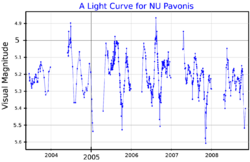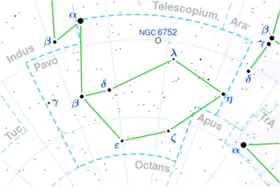Astronomy:NU Pavonis
| Observation data Equinox J2000.0]] (ICRS) | |
|---|---|
| Constellation | Pavo[1] |
| Right ascension | 20h 01m 44.74541s[1] |
| Declination | −59° 22′ 33.2173″[1] |
| Apparent magnitude (V) | 4.91 – 5.26[2] |
| Characteristics | |
| Evolutionary stage | AGB[3] |
| Spectral type | M6 III[4] |
| B−V color index | 1.356±0.011[1] |
| Variable type | SRb[2] |
| Astrometry | |
| Radial velocity (Rv) | −10.3±2.8[5] km/s |
| Proper motion (μ) | RA: +20.22[1] mas/yr Dec.: −27.05[1] mas/yr |
| Parallax (π) | 6.86 ± 0.26[1] mas |
| Distance | 480 ± 20 ly (146 ± 6 pc) |
| Absolute magnitude (MV) | −0.86[1] |
| Details | |
| Mass | 3.7[6] M☉ |
| Radius | 204±29[7] R☉ |
| Luminosity | 5,720±960[7] L☉ |
| Surface gravity (log g) | 0.87[8] cgs |
| Temperature | 3,516±275[7] K |
| Metallicity [Fe/H] | −0.28[6] dex |
| Other designations | |
| Database references | |
| SIMBAD | data |
NU Pavonis (N-U, not "nu") is a variable star in the southern constellation of Pavo. With an apparent visual magnitude of about 5, it is a faint star but visible to the naked eye. The distance to NU Pav, as determined from its annual parallax shift of 6.9 mas[1] as seen from Earth's orbit, is around 480 light years. It is moving closer with a heliocentric radial velocity of −10 km/s.[5]

This is an aging red giant with a stellar classification of M6 III,[4] currently on the asymptotic giant branch. Peter M. Corben listed HR 7625 as a possible variable star in 1971.[11] It was given its variable star designation, NU Pavonis, in 1973.[12] It is a semiregular variable star of sub-type SRb that ranges in magnitude from 4.91 down to 5.26 with a period of 60 days.[7] The star has expanded to 204 times the Sun's radius[7] and is radiating 7,412 times the Sun's luminosity from its enlarged photosphere[1] at an effective temperature of 3,516 K.[7]
Far-ultraviolet emission has been detected from the position of this star, which may be coming from a companion star.[8]
References
- ↑ 1.00 1.01 1.02 1.03 1.04 1.05 1.06 1.07 1.08 1.09 Anderson, E.; Francis, Ch. (2012). "XHIP: An extended hipparcos compilation". Astronomy Letters 38 (5): 331. doi:10.1134/S1063773712050015. Bibcode: 2012AstL...38..331A XHIP record for this object at VizieR.
- ↑ 2.0 2.1 Samus', N. N; Kazarovets, E. V; Durlevich, O. V; Kireeva, N. N; Pastukhova, E. N (2017). "General catalogue of variable stars: Version GCVS 5.1". Astronomy Reports 61 (1): 80. doi:10.1134/S1063772917010085. Bibcode: 2017ARep...61...80S.
- ↑ Eggen, Olin J. (July 1992). "Asymptotic Giant Branch Stars Near the Sun". The Astronomical Journal 104: 275. doi:10.1086/116239. Bibcode: 1992AJ....104..275E.
- ↑ 4.0 4.1 Houk, Nancy; Cowley, A. P. (1979). Michigan catalogue of two-dimensional spectral types for the HD stars. 1. Ann Arbor, Michigan: Dept. of Astronomy, University of Michigan. Bibcode: 1978mcts.book.....H.
- ↑ 5.0 5.1 Gontcharov, G. A. (November 2006). "Pulkovo Compilation of Radial Velocities for 35495 Hipparcos stars in a common system". Astronomy Letters 32 (11): 759–771. doi:10.1134/S1063773706110065. Bibcode: 2006AstL...32..759G.
- ↑ 6.0 6.1 Khalatyan, A.; Anders, F.; Chiappini, C.; Queiroz, A. B. A.; Nepal, S.; Dal Ponte, M.; Jordi, C.; Guiglion, G. et al. (2024). "Transferring spectroscopic stellar labels to 217 million Gaia DR3 XP stars with SHBoost". Astronomy and Astrophysics 691: A98. doi:10.1051/0004-6361/202451427. Bibcode: 2024A&A...691A..98K.
- ↑ 7.0 7.1 7.2 7.3 7.4 7.5 Arroyo-Torres, B. et al. (June 2014). "VLTI/AMBER observations of cold giant stars: atmospheric structures and fundamental parameters". Astronomy & Astrophysics 566: 11. doi:10.1051/0004-6361/201323264. A88. Bibcode: 2014A&A...566A..88A.
- ↑ 8.0 8.1 Ortiz, Roberto; Guerrero, Martín A. (2016). "Ultraviolet emission from main-sequence companions of AGB stars". Monthly Notices of the Royal Astronomical Society 461 (3): 3036. doi:10.1093/mnras/stw1547. Bibcode: 2016MNRAS.461.3036O.
- ↑ "NU Pav". SIMBAD. Centre de données astronomiques de Strasbourg. http://simbad.u-strasbg.fr/simbad/sim-basic?Ident=NU+Pav.
- ↑ Tabur, V.; Bedding, T. R.; Kiss, L. L.; Moon, T. T.; Szeidl, B.; Kjeldsen, H. (December 2009). "Long-term photometry and periods for 261 nearby pulsating M giants". Monthly Notices of the Royal Astronomical Society 400 (4): 1945–1961. doi:10.1111/j.1365-2966.2009.15588.x. Bibcode: 2009MNRAS.400.1945T.
- ↑ Corben, P. M. (1971). "Photoelectric Magnitudes and Colours for Bright Southern Stars". Monthly Notes of the Astron. Soc. Southern Africa 30: 37–50. Bibcode: 1971MNSSA..30...37C.
- ↑ Kukarkin, B. V.; Kholopov, P. N.; Kukarkina, N. P.; Perova, N. B. (October 1973). "59th Name-List of Variable Stars". Information Bulletin on Variable Stars 834: 1–22. Bibcode: 1973IBVS..834....1K. https://ibvs.konkoly.hu/pub/ibvs/0801/0834.pdf. Retrieved 14 December 2024.
 |

